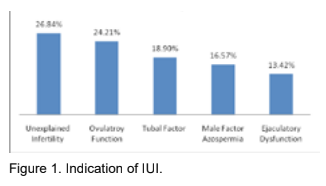Abstract
Introduction
The incidence of infertility is about 10 to 15 % among
reproductive age group. The cause of infertility may be either
due to male factor or female factor or both. The main aim of
this study was to evaluate the success rate of intrauterine
insemination (IUI) in a private centre of Pokhara.
Materials and Methods
This was a centre based retrospective study done in private
fertility centre. Sub-fertile couples who were treated from
January 1st 2015 to December 31st 2016 were enrolled for
the study. Couples with unexplained male factor, ovulatory
dysfunction, unilateral tubal occlusion and ejaculatory
dysfunction were included in this study. Three hundred and
eighty IUI cases were retrospectively reviewed. Clinical
pregnancy rate was the primary outcome.
Result
The success rate of IUI was 15.7%. It was higher among
unexplained infertility cases. Clinical pregnancy rate was
directly associated with the age of the patients, indications of
infertility and number of cycles.
Conclusion
Success rate of IUI in infertile couples who had unexplained
infertility, tubal factor, ovulatory dysfunction was higher than
male factor infertility and ejaculatory dysfunction.
References
(Oxford, England). 2016; 31(9):2108-2118.
2. Pai RD. Text book of IUI and ART. Delhi: Jaypee Brothers Medical Publisher; 2016.
3. Dinelli L et al. Prognosis factors of pregnancy after IUI with the husband semen. Fertility and sterility. 2014;101(4):994-1000.
4. Katsikis I, Kita M, Karkanaki A, Prapas N, Panidis D. Anovulation and ovulation induction. Hippokratia. 2006;10(3):120-7.
5. Merchant R, Gandhi G, Allahbadia GN. In vitro fertilization/intracytoplasmic sperm injection for male infertility. Indian J Urol.
2011;27:121-32.
6. World Health Organization. WHO laboratory manual for the examination and processing of human semen, 5th ed. Geneva: World
Health Organization; 2010.
7. Ombelet W. The revival of intrauterine insemination: evidence-based data have changed the picture. Facts, Views & Vision in
ObGyn. 2017;9(3):131-2.
8. Merviel P, Heraud MH, Grenier N, Lourdel E, Sanguinet P, Copin H. Predictive factors of pregnancy after IUI: an analysis of 1038
cycles and review of the literature. Fertility and Sterility. 2010;93(1):79-88
9. Monraisin, Oriana et al. Evaluation of intrauterine insemination practices: a 1-year prospective study in seven French assisted
reproduction technology centers. Fertility and Sterility. 2016; 105(6); 1589 - 93
10. Allahbadia GN, Chawla MM, Das RB, Gandhi GN, Garcia EV, Merchant R. The Art and Science of Assisted Reproductive
Techniques ( ART). 2nd Edition. Jaypee. Delhi; 2017.
11. Gomez R, Hahn T, Hoelscher-Obermaier J, Seufert R, Skala C. Success Rate of Inseminations Dependent on Maternal Age? An
Analysis of 4246 Insemination Cycles. Geburtshilfe und Frauenheilkunde. 2013;73(8):808-11.
12. Hansen KR, He ALW, Styer AK, et al. Predictors of Pregnancy and Live-Birth in Couples with Unexplained Infertility following
Ovarian Stimulation-Intrauterine Insemination. Fertility and Sterility. 2016;105(6):1575-1583.
13. Gunn DD, Bates GW et al. Evidence-based approach to unexplained infertility: a systematic review. Fertil Steril. 2016;105(6):1566-74.
14. Vlahos, Nikos F. et al. Women with ovulatory dysfunction undergoing ovarian stimulation with clomiphene citrate for intrauterine
insemination may benefit from administration of human chorionic gonadotropin. 2015; 83(5);1510-16.
15. Fode M, Krogh-Jespersen S, Brackett NL, Ohl DA, Lynne CM, Sønksen J. Male sexual dysfunction and infertility associated with
neurological disorders. Asian Journal of Andrology. 2012;14(1):61-68.
16. Lin MH, Hwu YM, Lin SY, Lee RK. Treatment of infertile women with unilateral tubal occlusion by intrauterine insemination and
ovarian stimulation. Taiwan? 2013; 52(3):360-4.
17. Yi G, Jee BC, Suh CS, Kim SH. Stimulated intrauterine insemination in women with unilateral tubal occlusion. Clinical and
Experimental Reproductive Medicine. 2012; 39(2):68-72.
18. Botchan A, Hauser R, Gamzu R, Yogev L, Paz G, Yavetz H. Results of 6139 artificial insemination cycles with donor spermatozoa.
Hum Reprod. 2001;16(11):2298-304.
19. Inge M. Custers, Pieternel Steures, Peter Hompes et al. intrauterine insemination: how many cycles should we perform? Human
Reproduction. 2008;23(4):885-8.

